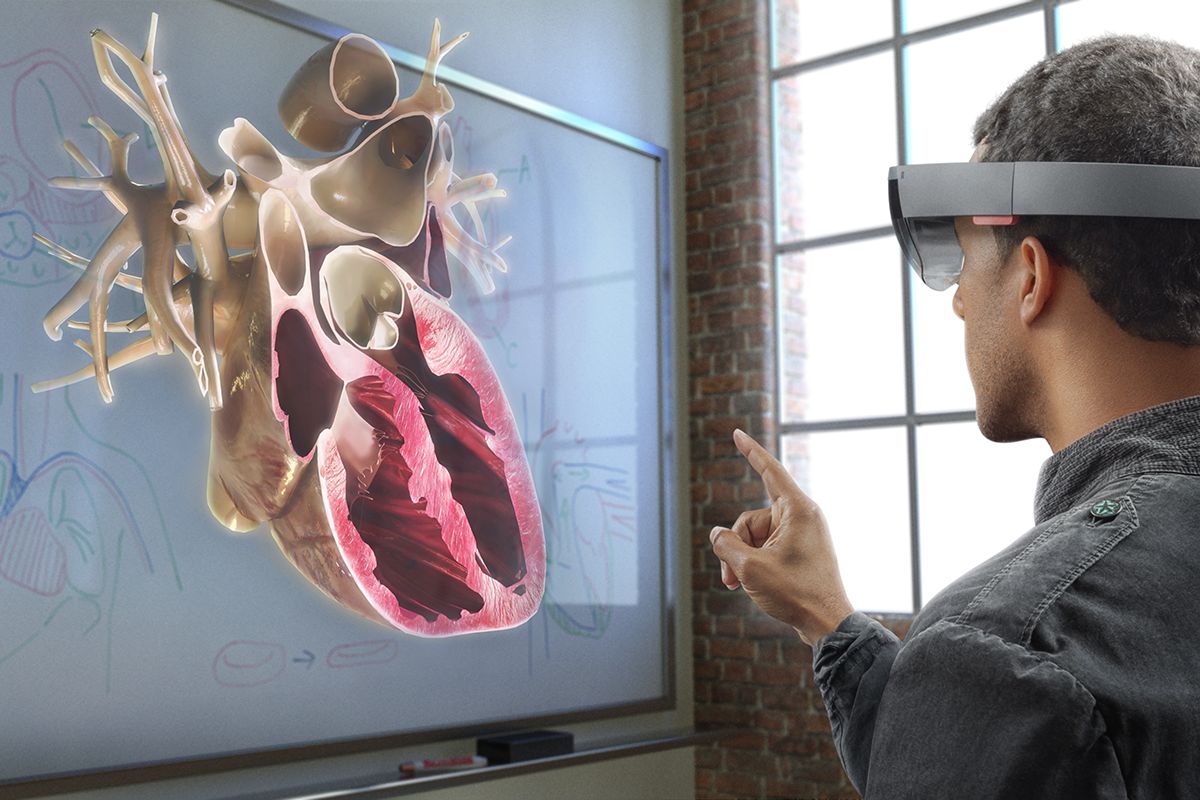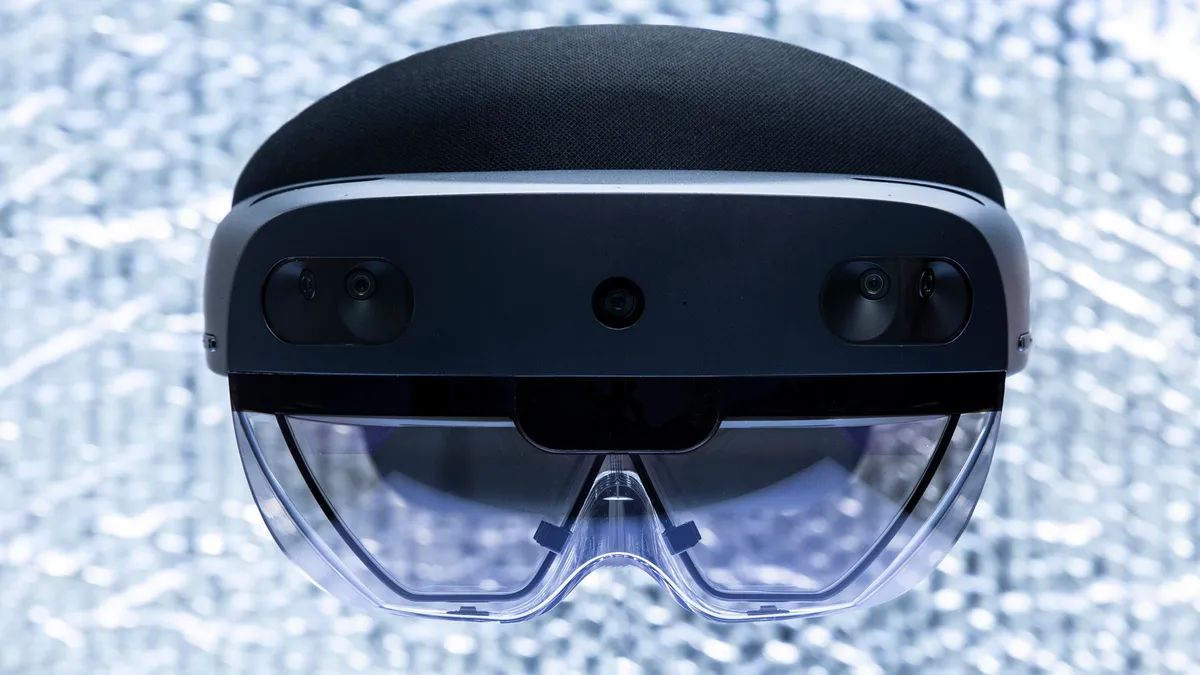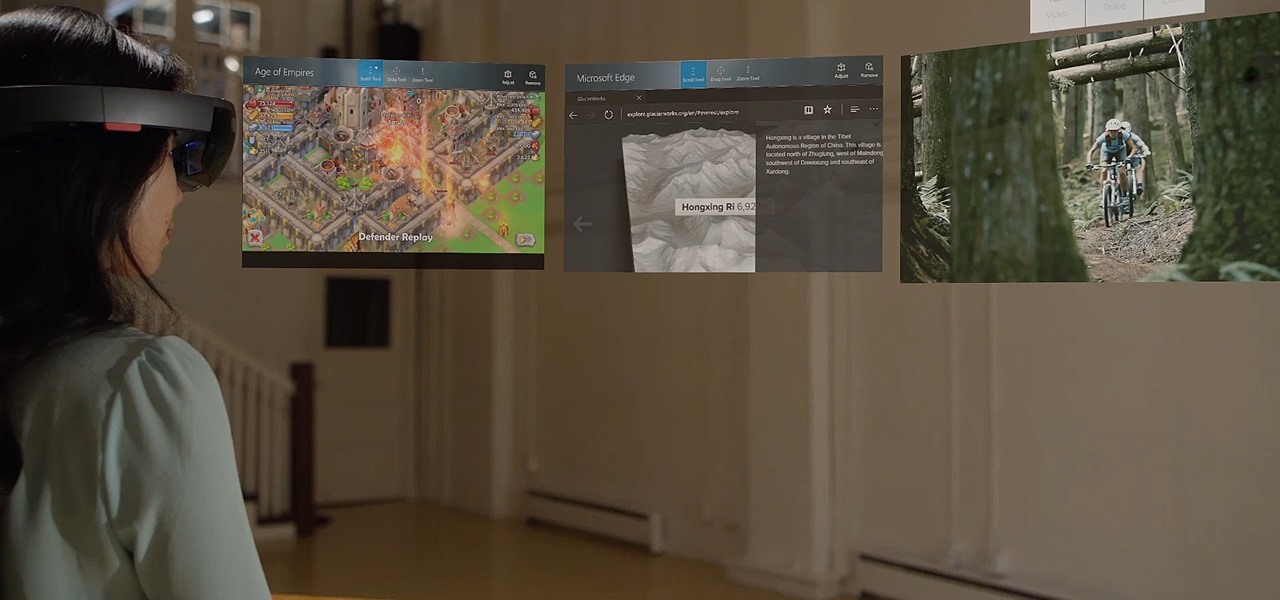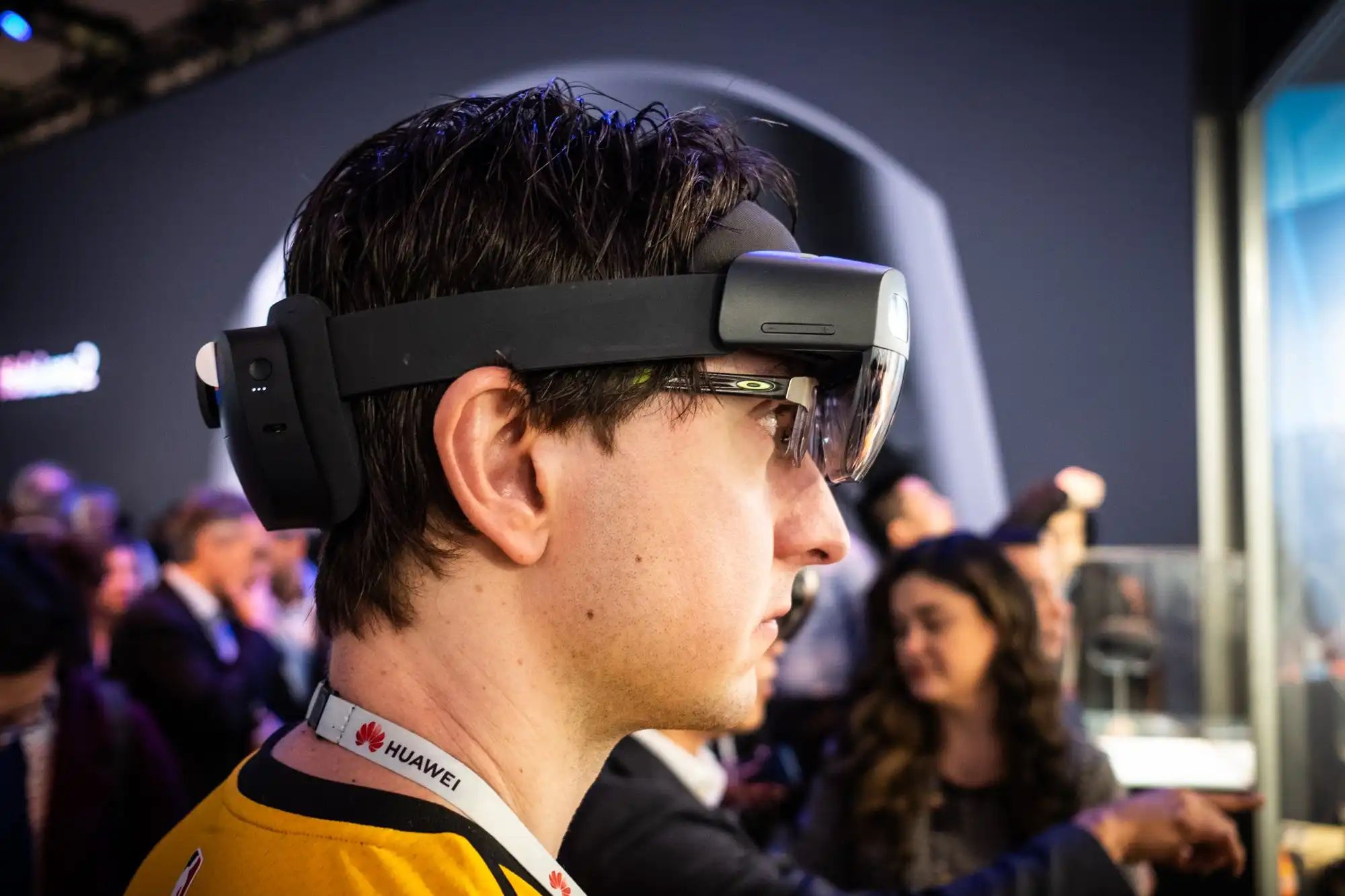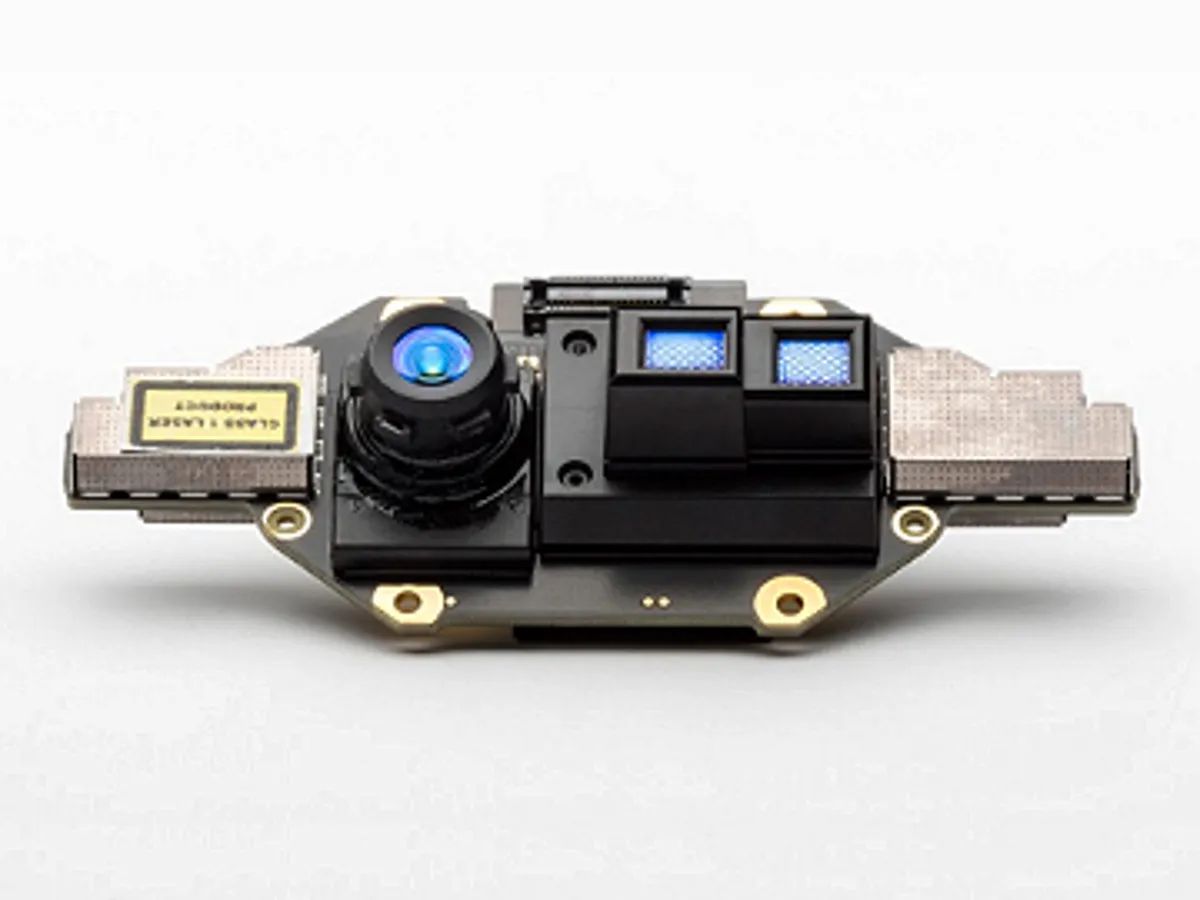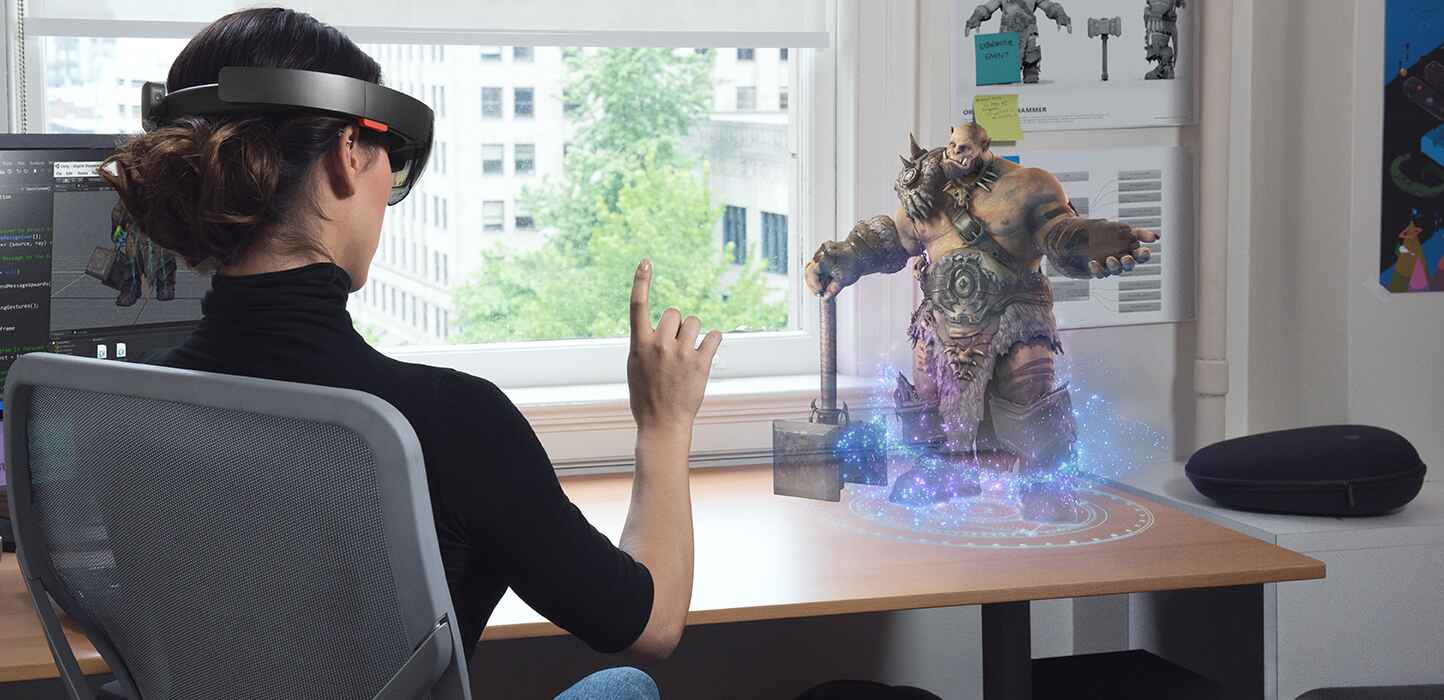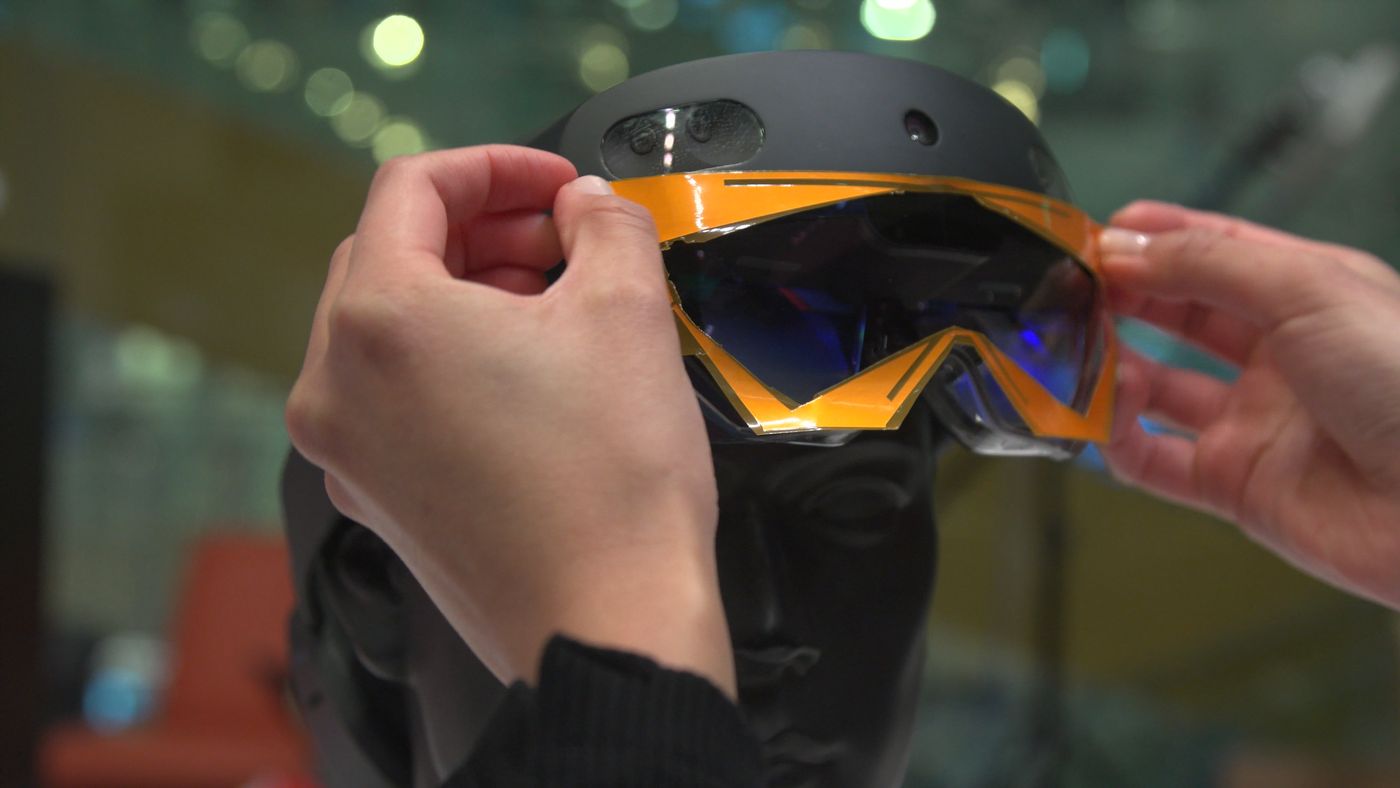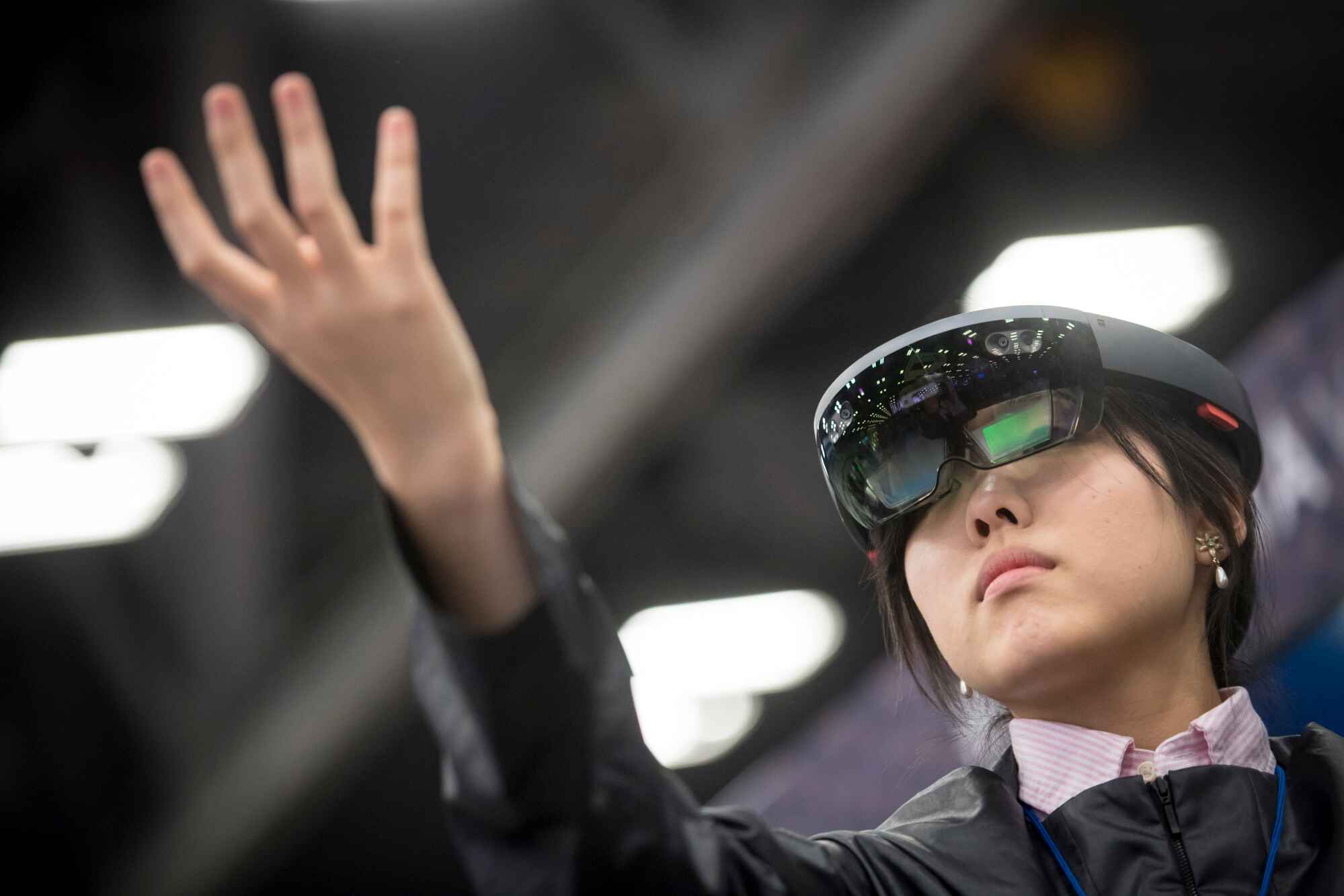Introduction
The HoloLens is a groundbreaking augmented reality device developed by Microsoft. It blends the physical and digital worlds, allowing users to interact with holograms in their real-world environment. With its cutting-edge technology and futuristic capabilities, the HoloLens has revolutionized the way we experience computing and has opened up new possibilities in various industries.
From the moment you put on the HoloLens, you are transported into a world where holograms become a part of your everyday life. Whether you’re exploring a new virtual landscape, designing complex structures, or collaborating remotely with colleagues, the HoloLens offers an immersive and interactive experience like no other.
One of the key features of the HoloLens is its ability to offer a hands-free experience. Unlike virtual reality devices that require controllers or handheld devices, the HoloLens allows users to interact with holograms using gestures, voice commands, and eye tracking. This natural and intuitive mode of interaction makes the HoloLens user-friendly and accessible to a wide range of audiences.
Another remarkable aspect of the HoloLens is its portability. The device is wireless and self-contained, eliminating the need for additional accessories or cables. This allows users to move freely and explore their environment without any restrictions. Whether you’re in a conference room, a construction site, or your own living room, the HoloLens adapts seamlessly to any setting, making it a versatile tool for both personal and professional use.
The HoloLens also boasts advanced sensors and cameras that enable it to map and perceive your physical space accurately. This spatial mapping capability allows the device to anchor holographic objects to specific locations in your environment, creating a realistic and seamless integration between the virtual and real worlds. Whether you’re placing a hologram on a table or interacting with virtual objects in mid-air, the HoloLens ensures precise tracking and alignment.
In the following sections, we will delve deeper into the specific design, display, optics, sensors, connectivity, sound, user interaction, and battery life of the HoloLens. By understanding these key aspects, you will gain a comprehensive understanding of what the HoloLens looks like and how it delivers its impressive augmented reality experience.
Design
The design of the HoloLens is sleek and futuristic, reflecting its innovative technology and cutting-edge capabilities. The device features a lightweight and balanced design, making it comfortable to wear for extended periods. The frame is made of durable materials that can withstand daily use and provide a sturdy foundation for the various components.
The HoloLens has an adjustable headband that allows users to customize the fit according to their preferences. This ensures a snug and secure fit, enabling users to move freely without worrying about the device slipping or becoming uncomfortable. The headband is also padded for added comfort, reducing any pressure points that may develop during prolonged use.
The front of the HoloLens is where the magic happens. It houses the transparent visor, which serves as the display for the holographic images. The visor is made of high-quality, scratch-resistant glass that provides a clear and vibrant viewing experience. It allows users to see the real-world environment while overlaying holographic images seamlessly, creating a mesmerizing blend of virtual and physical realities.
The sides of the HoloLens feature a series of sensors and cameras that enable the device to accurately track and map the user’s environment. These sensors work together to capture depth information, spatial mapping, and gestures, allowing the HoloLens to create a realistic and immersive augmented reality experience. The buttons and controls are strategically placed for easy access, ensuring a seamless user experience.
The HoloLens is designed to be portable and easy to use. It is a self-contained device that does not require any external wires or connections. This makes it convenient to carry and deploy in various settings, whether it’s for personal use or in a professional setting. The compact and ergonomic design ensures that users can wear the HoloLens comfortably for prolonged periods without experiencing fatigue or discomfort.
In terms of aesthetics, the HoloLens has a modern and minimalistic look. Its sleek and clean lines, combined with the high-quality materials used in its construction, give it a premium and sophisticated appearance. The device is available in a neutral color palette, allowing it to adapt seamlessly to any environment or outfit.
The design of the HoloLens not only enhances its functionality but also contributes to the overall user experience. Its lightweight and comfortable design, combined with its advanced sensors and controls, make it an intuitive and user-friendly device. Whether you’re a developer, a designer, or a casual user, the HoloLens offers a visually pleasing and immersive augmented reality experience.
Display
The display of the HoloLens is a remarkable piece of technology that brings holograms to life in a stunning and realistic manner. The device utilizes a transparent visor made of high-quality glass that allows users to see both the real world and the holographic images seamlessly. This unique display feature creates a mesmerizing augmented reality experience like no other.
The visor of the HoloLens has a high-resolution display that provides crisp and detailed visuals. The holographic images appear sharp and vibrant, enhancing the overall immersion and realism of the virtual objects. Whether you’re exploring a virtual landscape, examining a detailed 3D model, or watching videos, the display of the HoloLens delivers an impressive visual experience.
One of the key advantages of the HoloLens display is its ability to overlay holograms onto the user’s real-world environment. This means that you can interact with virtual objects while still maintaining spatial awareness and visibility of your surroundings. The holographic images seamlessly integrate with the real world, creating a sense of depth and realism that enhances the overall immersion and user experience.
The display of the HoloLens also offers a wide field of view, allowing users to see and interact with holograms across a large area. This expansive field of view ensures that users can fully engage with the virtual content without any restrictions or limitations. Whether you’re exploring a digital workspace, playing a game, or collaborating with others, the wide field of view enhances the sense of presence and interaction.
The HoloLens display is also capable of adjusting its brightness and transparency to adapt to different lighting conditions and preferences. This feature ensures that users can comfortably view holographic content in various environments, whether it’s a well-lit room or a dimly lit space. The display automatically adjusts to provide optimal visibility and clarity, enhancing the overall visual experience.
In addition to the impressive visuals, the HoloLens display also provides spatial sound. This means that the audio cues and effects associated with the holographic content are spatially mapped to their respective virtual locations. When you move around the holographic objects, the sound changes spatially, creating an immersive and realistic audio experience. This adds another layer of depth and realism to the overall augmented reality experience.
Overall, the display of the HoloLens delivers stunning visuals, expansive field of view, and spatial sound to create an immersive and realistic augmented reality experience. Whether you’re using it for gaming, design, education, or professional applications, the display capabilities of the HoloLens ensure an engaging and visually captivating experience.
Optics
The optics of the HoloLens play a crucial role in delivering the immersive and realistic augmented reality experience. The device utilizes a combination of displays, lenses, and sensors to create holographic images and project them seamlessly onto the user’s real-world environment.
At the heart of the HoloLens optics is a high-resolution display that renders the holographic content. The display features advanced pixel density and color accuracy, ensuring sharp and vibrant visuals. This allows the holographic images to appear crisp and realistic, enhancing the overall immersion and user experience.
To project the holographic images onto the user’s view, the HoloLens utilizes a series of waveguides and optics. These waveguides are transparent glass lenses that sit between the user’s eye and the display. The waveguides guide the light from the display and project it into the user’s field of view, creating the illusion that the holograms are seamlessly integrated with the real-world environment.
The waveguides also incorporate a complex system of diffraction gratings and reflection points that control the light and enable the holograms to appear as if they are floating in space. This holographic projection system ensures that the virtual objects appear at the correct depth and align with the user’s perspective, enhancing the realism and immersion of the augmented reality experience.
In addition to the waveguides and holographic projection system, the HoloLens optics include a set of sensors that enable spatial mapping and tracking. These sensors, such as depth cameras and infrared sensors, work in tandem to capture the user’s physical environment and create a digital representation of the space. This spatial mapping capability allows the HoloLens to anchor holograms to specific locations in the real world, creating a seamless blend of virtual and physical realities.
The HoloLens optics are designed to provide a comfortable viewing experience for users. The device incorporates an adjustable interpupillary distance (IPD) to accommodate users with different eye alignments. This ensures that the holographic content appears clear and properly aligned, reducing visual discomfort and fatigue during prolonged use.
Overall, the optics of the HoloLens are intricately designed to deliver a compelling augmented reality experience. The combination of high-resolution displays, waveguides, holographic projection system, and spatial mapping sensors work together to create realistic and immersive holographic images that seamlessly blend with the user’s real-world environment. These optics ensure that the HoloLens provides a visually captivating and engaging augmented reality experience for various applications and industries.
Sensors
The HoloLens is equipped with a range of sensors that enable it to perceive and interact with the user’s environment in a dynamic and precise manner. These sensors play a crucial role in tracking movement, mapping the physical space, and facilitating intuitive user interaction with the holographic content.
One of the key sensors in the HoloLens is the depth camera, which uses infrared technology to capture the depth information of the user’s surroundings. This sensor enables the device to create a 3D map of the environment, allowing holograms to accurately interact with real-world objects and surfaces. With the depth camera, the HoloLens can detect the user’s hand movements, gestures, and even spatial awareness, ensuring a seamless and natural interaction with the holographic content.
In addition to the depth camera, the HoloLens also incorporates an array of environment understanding cameras. These cameras work together to capture high-resolution images of the user’s surroundings, allowing the device to recognize and understand the environment. This enables the HoloLens to accurately track the user’s position, recognize objects, and create a seamless blend of virtual and real-world elements.
Another important sensor in the HoloLens is the inertial measurement unit (IMU). The IMU consists of gyroscopes, accelerometers, and magnetometers, which collectively measure the device’s orientation and movement. This sensor fusion technology ensures that the HoloLens accurately tracks the user’s head movements and maintains the correct alignment of holograms with the user’s perspective. It also contributes to the overall stability and smoothness of the augmented reality experience.
The HoloLens is also equipped with front-facing cameras that enable the device to capture high-quality images and videos of the user’s surroundings. This functionality is particularly useful for applications such as remote collaboration and documentation, where users can share their augmented reality experiences with others in real-time.
The combination of these sensors in the HoloLens enables it to deliver a seamless and interactive augmented reality experience. The depth camera, environment understanding cameras, IMU, and front-facing cameras work harmoniously to enable precise tracking, realistic spatial mapping, and intuitive user interaction. This allows users to effortlessly manipulate holograms, explore virtual landscapes, and collaborate with others in a natural and immersive way.
Overall, the sensors in the HoloLens are a key component of its advanced technology, enabling the device to perceive and understand the user’s environment accurately. These sensors contribute to the seamless integration of virtual and real-world elements, resulting in a truly immersive and interactive augmented reality experience.
Connectivity
The HoloLens offers versatile connectivity options that allow users to seamlessly integrate the device into their existing digital ecosystem. It is equipped with various connectivity features that enable data transfer, communication, and collaboration, enhancing the overall functionality and utility of the device.
One of the key connectivity options of the HoloLens is Wi-Fi. The device supports high-speed wireless connectivity, allowing users to access the internet, stream content, and download applications and updates. With Wi-Fi connectivity, users can explore new virtual environments, access cloud-based services, and stay connected to a world of information and resources.
Bluetooth is another essential connectivity feature of the HoloLens. It enables users to connect and pair the device with external peripherals, such as keyboards, mice, game controllers, and other compatible devices. This allows for expanded functionality and control options, especially in scenarios that require precise input or extended interactions.
The HoloLens also supports USB connectivity through its USB-C port. This port enables users to connect external devices, such as storage devices or cameras, to transfer data or expand the device’s capabilities. USB connectivity is especially useful for content creators, enabling them to import and export files seamlessly between the HoloLens and other devices.
In addition to these connectivity options, the HoloLens is equipped with integrated microphones and speakers, enabling voice commands and audio output. This facilitates natural and hands-free interaction with the device, allowing users to control applications, navigate menus, and communicate with others without the need for physical input devices.
Furthermore, the HoloLens supports Miracast, a wireless display technology. This allows users to wirelessly mirror the device’s screen onto a compatible display, such as a TV or projector. This feature enhances collaboration and presentation scenarios, enabling users to share their augmented reality experiences with a larger audience.
The HoloLens is designed to be compatible with various software development frameworks and platforms. This allows developers to create applications and experiences that leverage the connectivity options of the device, enabling seamless integration with cloud services, data sharing, and real-time collaboration.
Overall, the connectivity options of the HoloLens provide users with the flexibility to connect and interact with external devices and services. Wi-Fi, Bluetooth, USB, and Miracast enable seamless data transfer, peripheral connectivity, and screen sharing, enhancing the overall functionality and versatility of the device. These connectivity features make the HoloLens a powerful and adaptable tool for a wide range of applications and industries.
Sound
The sound capabilities of the HoloLens are essential components that enhance the overall immersive augmented reality experience. The device incorporates spatial sound technology, ensuring a realistic and engaging auditory experience that complements the visual holographic content.
The HoloLens features built-in speakers that deliver high-quality audio output. These speakers are strategically positioned to provide an immersive and directional sound experience. With spatial sound technology, the audio cues and effects associated with the holographic content are precisely mapped to their respective virtual locations, creating a sense of depth and realism.
The spatial sound technology in the HoloLens creates a rich and immersive auditory experience. As users move around the holographic objects, the sound dynamically adjusts and changes spatially, further enhancing the realism of the augmented reality environment. This adds another layer of depth and immersion, making the holograms feel even more lifelike and integrated into the user’s surroundings.
The HoloLens also includes integrated microphones that support voice commands and audio input. These microphones enable hands-free interactions, allowing users to control applications, make voice calls, and communicate with virtual characters or other users without the need for physical input devices. The high-quality microphones ensure clear and accurate voice capture, enhancing the overall user experience.
Furthermore, the HoloLens supports spatial audio APIs, enabling developers to create customized audio experiences for their applications. With these APIs, developers can precisely control the positioning, volume, and spatial properties of audio sources within the augmented reality space. This flexibility allows for creative and immersive audio scenarios, enhancing the overall impact and engagement of the augmented reality experience.
Users can also connect external audio devices, such as headphones or speakers, to the HoloLens for a more personalized and immersive audio experience. This feature is particularly useful in scenarios where users want to have a private or enhanced audio experience, or when collaborating in larger groups where a higher level of audio fidelity is desired.
The sound capabilities of the HoloLens contribute to the overall sense of immersion and realism in the augmented reality environment. The combination of high-quality speakers, spatial sound technology, integrated microphones, and support for external audio devices ensures a rich and engaging audio experience that complements the immersive visual holographic content.
User Interaction
The HoloLens offers a unique and intuitive user interaction experience, allowing users to seamlessly interact with holographic content in their real-world environment. With its combination of gesture recognition, voice commands, and eye-tracking, the HoloLens provides a natural and immersive way to engage with augmented reality.
One of the primary methods of interaction with the HoloLens is through hand gestures. The device utilizes advanced sensors and cameras to track the user’s hand movements and gestures. Users can scroll, pinch-to-zoom, tap, and perform various hand gestures to manipulate holographic objects. This intuitive gestural interface allows for precise and fluid control over the virtual content, making interactions feel more natural and immersive.
Voice commands are another key aspect of interaction with the HoloLens. Users can control applications, navigate menus, and execute actions through a range of voice commands. The device incorporates high-quality microphones and advanced speech recognition technology to accurately capture and interpret user commands. This hands-free interaction method allows for a seamless and efficient user experience, especially in scenarios where hand gestures may not be practical or necessary.
Eye-tracking is a unique feature of the HoloLens that enhances the user interaction experience. The device can detect the user’s eye movements and use this information to track their focus and attention. This allows holograms to respond to the user’s gaze, creating a more dynamic and interactive experience. For example, users can activate or select holographic objects simply by looking at them, enhancing the sense of control and immersion.
The HoloLens also supports external input devices such as keyboards, mice, and game controllers. This expands the range of interaction options, providing users with familiar input methods for specific tasks or applications. The device seamlessly integrates with these external devices, offering flexibility and catering to different user preferences and needs.
Developers also have the ability to create custom interactions and gestures using the HoloLens development platform. This allows for the creation of unique and tailored user interaction experiences based on specific application requirements. It enables developers to design experiences that fit the context and purpose of the augmented reality content, further enhancing user engagement and immersion.
The combination of hand gestures, voice commands, and eye-tracking provides users with a rich and intuitive interaction experience with the HoloLens. Whether it’s navigating virtual environments, manipulating holographic objects, or executing commands, the device offers a seamless and immersive way to engage and interact with augmented reality content.
Battery Life
Battery life is an important consideration for any portable device, and the HoloLens is no exception. The device is designed to provide a long-lasting and reliable power source to support extended periods of use. However, as a sophisticated augmented reality device, the battery life of the HoloLens can vary depending on usage and various factors.
The HoloLens features a built-in rechargeable battery that is seamlessly integrated into its compact and lightweight design. The battery capacity is optimized to offer prolonged operation, allowing users to engage with holographic content for extended periods without the need for frequent recharging.
The actual battery life of the HoloLens depends on multiple factors, including the intensity and duration of usage, the specific applications or tasks being performed, and the overall power consumption of the device. Engaging in resource-intensive activities such as running graphics-intensive applications or streaming high-definition content can consume more power and result in a shorter battery life.
Microsoft has designed the HoloLens with power-saving features to optimize battery usage. The device is equipped with sensors that detect when it is not being used and automatically enters into a low-power mode to conserve energy. This helps to prolong the battery life when the HoloLens is not actively in use, such as when it is placed on a table or when the user’s attention is focused elsewhere.
To charge the HoloLens, it comes with a charging cable and a power adapter. Simply connect the device to a power source using the provided charger, and it will recharge the battery. The HoloLens also supports fast charging technology, which allows for a quicker recharge time compared to traditional charging methods.
It is worth noting that the battery life of the HoloLens can also be influenced by factors such as the ambient temperature and the age of the device. Extreme temperatures can affect the performance and efficiency of the battery, while older batteries may not hold a charge as effectively as brand new ones.
While the HoloLens offers a dependable battery life, it is advisable to keep an eye on the battery level and plan accordingly for longer usage sessions. Carrying a portable power bank or having access to a power source for recharging can ensure uninterrupted use of the HoloLens when needed.
Overall, the HoloLens delivers a satisfactory battery life to support extended use. Microsoft has implemented power-saving features and optimized the battery capacity to provide users with a seamless and immersive augmented reality experience for extended periods without the need for frequent recharging.
Conclusion
The HoloLens is a remarkable augmented reality device developed by Microsoft that has redefined the way we interact with digital content in the world around us. With its sleek design, high-resolution display, advanced sensors, and intuitive user interaction capabilities, the HoloLens offers a truly immersive and realistic augmented reality experience.
The design of the HoloLens is not only visually appealing but also ergonomic, ensuring comfort during extended use. The transparent visor provides a clear and vibrant display, seamlessly blending holographic content with the real world. The device’s sensors enable accurate spatial mapping and tracking, creating a seamless integration between virtual and physical elements.
The HoloLens offers versatile connectivity options, including Wi-Fi, Bluetooth, USB, and Miracast, enabling seamless integration with external devices and services. The sound capabilities, with its spatial audio technology, provide an immersive auditory experience that complements the visual content. The device’s user interaction methods, including hand gestures, voice commands, and eye-tracking, offer a natural and intuitive way to engage with holographic content.
While the battery life may vary based on usage, the HoloLens is designed to provide a long-lasting power source, allowing for extended periods of engagement with augmented reality content. The device’s power-saving features help optimize battery usage and ensure efficient operation.
Overall, the HoloLens is a groundbreaking device that has opened up new possibilities in various industries, including gaming, design, education, and enterprise. With its powerful technology and versatile capabilities, the HoloLens has unleashed a new era of augmented reality experiences, allowing users to blend the digital and physical worlds seamlessly.
Whether you’re exploring virtual landscapes, collaborating remotely, or designing complex structures, the HoloLens offers a captivating and immersive augmented reality experience that pushes the boundaries of what is possible. As the technology continues to evolve, the future of augmented reality looks bright, and the HoloLens remains at the forefront of this exciting journey.







